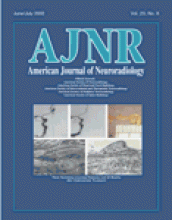Abstract
BACKGROUND AND PURPOSE: In patients with clinical symptoms suggestive of a retrocochlear disorder, contrast-enhanced T1-weighted spin-echo (SE) high-field-strength MR imaging is considered the criterion standard in assessing vestibular schwannoma. However, only 10–20% of its findings are pathologic. Our purpose was to prospectively compare the performance of low-field-strength MR imaging in screening for retrocochlear disorders, with high-field-strength MR imaging as the criterion standard.
METHODS: A total of 287 patients with suspected retrocochlear disease underwent axial 1.5-T MR imaging with a T1-weighted SE sequence before and after contrast enhancement and with a high-resolution T2-weighted construction interference in steady state sequence. At immediate follow-up, the same patients underwent axial 0.2-T T1-weighted SE imaging without additional contrast enhancement. Results were classified as negative, positive, or uncertain and were analyzed in light of the patients’ clinical symptoms.
RESULTS: MR imaging at 1.5 T depicted 63 disorders (21.95%), including 53 schwannomas, three other tumors, and seven other disorders (ie, gadolinium-enhancing inner ear, facial nerve, or meninges). MR imaging at 0.2 T showed evidence of 58 disorders; five disorders were not detected, although all schwannomas and other tumors were seen, including those smaller than 2 mm, and only two (28.6%) of the other disorders were detected. When correlated with clinical data, results showed that the five undetected disorders occurred in patients with unusual clinical signs.
CONCLUSION: MR imaging at 0.2 T provided high sensitivity in detecting vestibular schwannoma of the internal auditory canal or cerebellopontine angle; it can be used for mass screening for this disease. Positive and uncertain imaging findings should be followed up with high-field-strength MR imaging.
- Copyright © American Society of Neuroradiology












